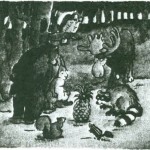eggplant versus pineapple
The Story of the Rabbit and the Eggplant by Daniel Pinkwater
Once there was a race between a rabbit and an eggplant. Now, the eggplant, as you know, is a member of the vegetable kingdom, and the rabbit is a very fast animal.
Everybody bet lots of money on the eggplant, thinking that if a vegetable challenges a live animal with four legs to a race, then it must be that the vegetable knows something.
People expected the eggplant to win the race by some clever trick of philosophy. The race was started, and there was a lot of cheering. The rabbit streaked out of sight.
The eggplant just sat there at the starting line. Everybody knew that in some surprising way the eggplant would wind up winning the race.
Nothing of the sort happened. Eventually, the rabbit crossed the finish line and the eggplant hadn’t moved an inch.
The spectators ate the eggplant.
Moral: Never bet on an eggplant.

The Hare and the Pineapple
by Daniel Pinkwater  Alan Smithee
In olden times, the animals of the forest could speak English just like you and me. One day, a pineapple challenged a hare to a race.
(I forgot to mention, fruits and vegetables were able to speak too.)
A hare is like a rabbit, only skinnier and faster. This particular hare was known to be the fastest animal in the forest.
“You, a pineapple have the nerve to challenge me, a hare, to a race,†the hare asked the pineapple. “This must be some sort of joke.â€
“No,†said the pineapple. “I want to race you. Twenty-six miles, and may the best animal win.”
“You aren’t even an animal!” the hare said. “You’re a tropical fruit!”
“Well, you know what I mean,†the pineapple said.
The animals of the forest thought it was very strange that tropical fruit should want to race a very fast animal.
“The pineapple has some trick up its sleeve,” a moose said.
Pineapples don’t have sleeves, an owl said.
“Well, you know what I mean,†the moose said. “If a pineapple challenges a hare to a race, it must be that the pineapple knows some secret trick that will allow it to win.â€
“The pineapple probably expects us to root for the hare and then look like fools when it loses,†said a crow. “Then the pineapple will win the race because the hare is overconfident and takes a nap, or gets lost, or something.â€
The animals agreed that this made sense. There was no reason a pineapple should challenge a hare unless it had a clever plan of some sort. So the animals, wanting to back a winner, all cheered for the pineapple.
When the race began, the hare sprinted forward and was out of sight in less than a minute. The pineapple just sat there, never moving an inch.
The animals crowded around watching to see how the pineapple was going to cleverly beat the hare. Two hours later when the hare cross the finish line, the pineapple was still sitting still and hadn’t moved an inch.
The animals ate the pineapple.
MORAL: Pineapples don’t have sleeves
Beginning with paragraph 4, in what order are the events in the story told?
A switching back and forth between places
B In the order in which the events happen
C Switching back and forth between the past and the present
D In the order in which the hare tells the events to another animal
The animals ate the pineapple most likely because they were
A Hungry
B Excited
C Annoyed
D Amused
Which animal spoke the wisest words?
A The hare
B The moose
C The crow
D The owl
Before the race, how did the animals feel toward the pineapple?
A Suspicious
B Kindly
C Sympathetic
D Envious
What would have happened if the animals had decided to cheer for the hare?
A The pineapple would have won the race.
B They would have been mad at the hare for winning.
C The hare would have just sat there and not moved.
D They would have been happy to have cheered for a winner.
When the moose said that the pineapple has some trick up its sleeve, he means that the pineapple
A is wearing a disguise
B wants to show the animals a trick
C has a plan to fool the animals
D is going to put something out of its sleeve
………………………………………
Hm. Â I say throw out the multiple choice questions and make the students compose an essay comparing and contrasting the two versions of this fable.